Lucca
Today we visit Lucca, only 12 miles away from probably the most famous leaning tower in the world—Pisa—for a pleasant stroll through history and music.
A great choice to escape the heat of touristy Florence, Lucca is on the way to the coast at only 17 miles from Viareggio—the carnival town we visited in February.
Around the year 1100 Lucca was one of the major cities in Italy in terms of silk production and trade. The prosperity of the city was also enriched thanks to the continuous pilgrimages from all over Europe; it was, in fact, one of the main destinations of the Via Franchigena. The town also flourished during the Renaissance (mid-15th to the end of 16th century) from which many legacies have been left.
WALLS
The perfectly preserved defensive city walls are probably the best place to start our visit. Surrounding the old town for two-and-a-half miles, the 39-foot-tall brick and stone structure will allow you to walk through history and understand the dynamic of the city in the past.
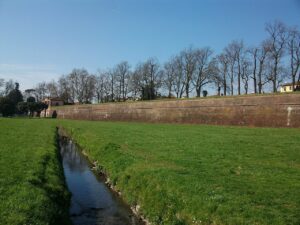
There are six places where you can access the inner town, most of which are pedestrian only, and many walks are available inside the wall as well as on the top. However, we are sure you will also enjoy a stroll on the outer circle too. This will take you through tree-lined avenues, gardens, fountains, and green paths which you can cover on foot or by bike. Built during the 16th century, the walls follow the original Roman defensive lines.
ROOTS
Lucca was founded in the 2nd century BC by the Romans, but the origins of the city are believed to be pre-Etruscan, specifically Celto-Ligurian, one of the first European populations.
For a long time, its name was believed to come from the Celto-Ligurian stem luk—meaning marshy place. However, the most probable option links the name back to the Latin word lucus—sacred woods—and the more ancient term leuk—bright place—to describe the wooded area deforested to make it lighter where the city was established. In any case, the Roman foundation shaped the city and left its mark on the current urban planning.

Piazza San Michele is dominated by a white marble church—one of a hundred churches in the city—and is known as the “Square of the Chains” (Piazza delle Catene) because of the numerous chains that connect the marble columns. It was built on the Roman Forum. While admiring the four sets of columns that rise upwards on the marvelous church façade, see if you can spot, right at the top, the shining sword of the San Michele statue, used by the saint to kill the evil dragon.
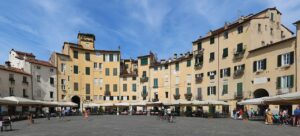
The beautiful and distinctive square of Piazza dell’Anfiteatro is so called in Italian because it is actually an oval and is built on the footprint of the ancient Roman amphitheater. An interesting fact is that, until the 1800s, the buildings that overlook the square were used as salt deposits, gunpowder storehouses, and even as a prison, until the revival of the ancient structure. Today it’s a perfect place to enjoy a tasty and colorful Italian meal in a relaxing atmosphere, enhanced by the fact that the square has no large streets leading to it which helps maintain the calm vibes throughout the day.
CYCLING AROUND
The bike is the perfect means of transportation to explore Lucca in an eco-friendly way, not only in the city center but also around it.
The soothing Tuscan countryside, with its gentle hilly views, is an inviting destination for a bike ride as well as offering opportunities for enjoyable pitstops at vineyards for wine tasting and a homemade appetizer.
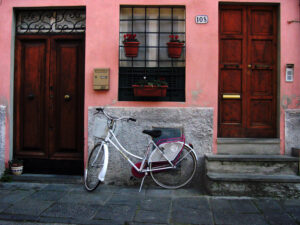
Lucca offers plenty of options for outdoor excursions such as hiking or village visits, although the cultural events program is rich enough to keep you in the city for days.
Among the other festivals, the opera calendar is also packed with high-profile performances.
This year, the city celebrates the 100th Anniversary of the death of the opera master Puccini, the prestigious composer of evergreen masterworks such as Madam Butterfly and Tosca.
THE MASTER
Giacomo Puccini was born in Lucca in 1858, and was one of the greatest exponents of operatic realism—Verismo in Italian—a post-romantic opera tradition that has a parallel in the literary world of the Naturalism movement, with authors such as Émile Zola and others, where great space was given to the fine details of real life.
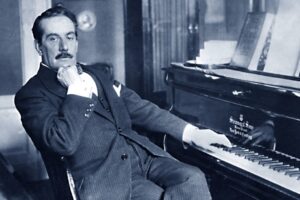
A curious fact is that the composer started to get involved with music not as a personal vocation, but more as a family tradition he needed to embrace. For more than a century, members of his family had worked in the role of music management at San Martino Cathedral and Giacomo was supposed to inherit this role from his father, but he was too young—only six years old—when his father died. In any case, he still remained actively involved in the musical life of the cathedral, being a member of the choir as a boy and also playing as an organist.
He developed a love and passion for music and, thanks to his uncle and the support received from important figures, after getting a diploma from the Pacini School of Music in Lucca in 1880, he was able to complete his studies at the prestigious Milan Conservatory, where he studied with the best teachers of the time.
FEMALE POWER
Female heroines are the main protagonists of all his most famous works, each of which are intense and tragic stories of passionate love.
In some cases they depict unrequited love, such as Madam Butterfly (1904) where a young Japanese woman falls in love with an American naval officer. The premier, however, was disastrous and the composer needed to re-write it five times until he reached what we now know as the current work, referred to as the “standard version”. Regardless of its troubled beginning and adjustments, the opera became extremely successful worldwide.
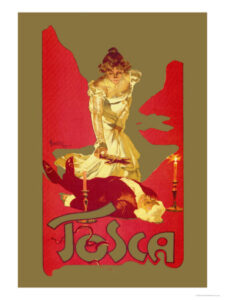
Other works include stories of betrayal, jealousy, and corruption, like the red-blooded Tosca (1900) which openly presents scenes of torture, murder, and suicide. The story tells the tale of the opera singer Floria Tosca, living and working in Rome, who fights to save her lover from the mean police chief Scarpia.
La bohème, probably the other best known Puccini opera, was first presented in Turin in 1896, directed by Arturo Toscanini, and it is the most frequently performed opera ever written. Like Tosca, this opera was acclaimed from the beginning by the public, and also, uniquely, by the critics. It was performed at all the main opera houses in Europe and also the United States.
Beyond the opera festival, named the Puccini Festival after his celebrated father, which we highly recommend if you are keen, or even curious, to experience a full emotional journey in the Italian opera, there are other options.
The Lucca Summer Festival, for instance, has an astonishing lineup of national and international music artists who will perform a kaleidoscopic of genres. This year, from June to July, big names such as Ed Sheeran to Eric Clapton, from Duran Duran to Rod Stewart will perform for huge crowds continuing a modern tradition that started in 1998, which adds yet more charm to a small, pretty Italian town.
This list of sightseeing and events is not exhaustive, and we would love to guide you through the other exclusive options that the town and the region has to offer.
Reach out to us today to start crafting your tailor-made trip to Lucca and the Tuscan countryside.
Words by Elisa Spampinato
Cover image: Photo credits @Pietro Colnago from Wikimedia Commons


